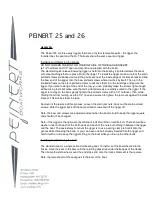
Safety
Your Pro-Line boat has been constructed with safety in mind. However, the ultimate
safety of you and your passengers is in your hands. Plan your trips carefully. Insure
ample fuel supply and a reserve. Tell someone where you are going and when you
expect to return. Keep current charts onboard. Read USCG boating safety circulars and
follow the safety guidelines.
Regulations
The USCG is the authority of all waterways. State boating regulations, are enforced by
local authorities. You are subject to marine traffic laws and "Rules of the Road" for both
federal and state waterways. Therefore, you must submit to boarding if requested by
proper authority. There are many publications available from the Coast Guard
concerning regulations. Call the Boating Safety Hot Line at (800)-368-5647 for
additional information.
Equipment
USCG regulations require the following Coast Guard approved equipment while
operating your boat:
* Fire extinguisher
* Personal Flotation Device (PFD) for each occupant
* One throwable PFD
* Sound signal device
* Navigational lights if operated at night
* Sight signal device (approved for day and night use) when in coastal waters or
great lakes.
In addition, here is a list of suggested equipment you should have aboard your Pro-Line:
* First aid kit and blankets
* Anchor and sea anchor with sufficient line
* Mooring lines and fenders
* Bailing device
* Combination oar / boat hook
* Tool kit and lubricant
* Spare prop and hardware
* Spare fasteners, hose clamps, and plugs
* Spare fuses and bulbs
* Binoculars
* Local charts and compass
* Waterproof flashlight and spare batteries
* 2 way radio
* EPIRB (emergency beacon)
* Floating key chain and spare keys * Navigation device
* Emergency food and water
* Waterproof matches or lighter
Passenger Safety
You are responsible for the safety and conduct of your passengers. Make sure that:
* You instruct passengers on proper use and location of PFD's. Children
and non-swimmers should wear one at all times.
* Each passenger is in a safe location when underway and knows to keep
the boat balanced.
* At least one other person knows how to operate the boat in case of emergency.
* They are aware of prop dangers and the possibility of sudden maneuvers and
jolts.
* The engine is turned off and the key is removed when swimmers are near the
prop or using the dive platform.
* All passengers keep away from lines under stress in case they break and recoil.






































